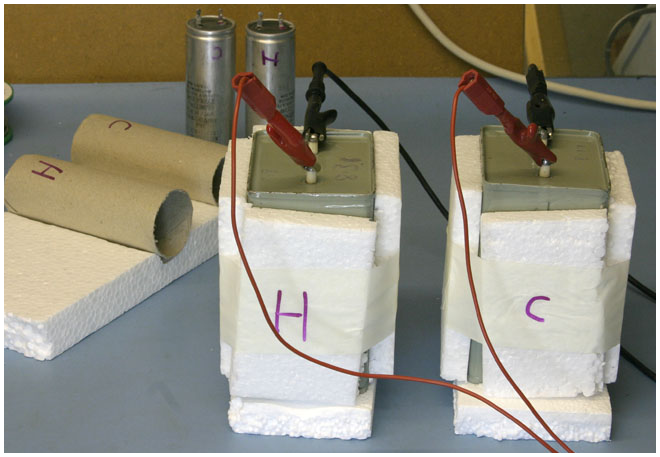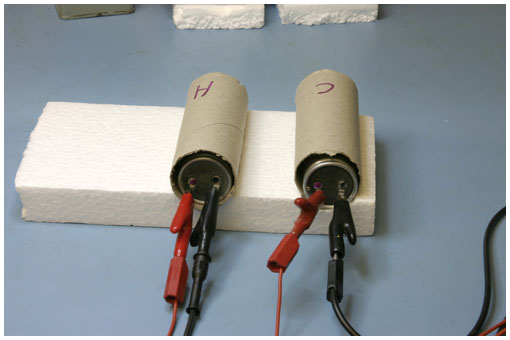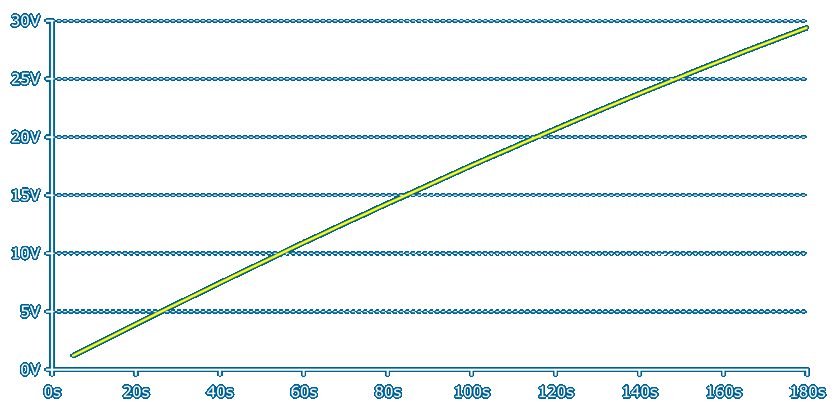I suggest elsewhere on this website that the capacitor soakage effect may be due to dielectric compression and or loose winding and that neither is a linear effect ~ If the plates of a capacitor can be pulled together by the opposite charges them the capacitance should change at twice the rate of an applied a.c. current provided the plates can respond fast enough or they hit a resonant overtone [or undertone ?] frequency
Considering the way dielectric compression may work I have conducted many tests looking for the production of even harmonics by paper in oil capacitors which could explain why they sound 'musical' and 'warm' ~ At present these tests have not proved conclusive so here are some more d.c. tests related to capacitor soakage or is it dielectric compression

Many Hi–Fi audio components are now cryogenically frozen and claim a "better sound" which I think is complete **** especially for thermionic valves
But what if a capacitor with compressible dielectric is frozen?
Would the dielectric compression effect while "frozen solid" as measured by a rise in open terminal voltage after discharge be reduced ?
In the picture 2 pairs of identical capacitors that both exhibit 'soakage' as defined by the fact that when charged for a long time and then short circuited they produce a voltagef across their terminals when the short circuit is removed ~ This voltage rises slowly with time provided the measuring equipment load is very high or connected intermittently
The capacitors in front covered in polystyrene insulation are 8µF 1000V paper and NITROGOL which is a thick insulating oil ~ In the background are a pair of 16µF 500V TCC electrolytics ~ Both caps in each pair were from the same production batch unused and are over 40 years old
Nitrogol and electrolytic capacitors both have porous paper as a "spacer" between the plates ~ I cut open several samples of each type and found the rolled up cores of aluminium foil and paper were easily deformed ~ especially the electrolytics ~ But after freezing to about –18˚C both types become very hard to deform ~ The Nitrogol was like a very hard wax while the electrolytic appeared to freeze to ice
All capacitor types were tested as pairs using the same technique ~ At room temperature they were charged in parallel to their working voltage using a Fluke 343A supply for at least 10 minutes ~ Then the Fluke voltage was quickly reduced to 0V which shorts the caps and when discharged to 0V the +Ve leads were removed at the same time leaving the –Ve leads connected to the fluke along with a volt meter –Ve lead
The volt meter used had 10MΩ input impedance and its +Ve lead was only connected to each capacitor for a second to measure the terminal voltage so there was very little loading between readings ~ Although I have equipment that can measure and record readings against time ~ I did not want this to become an absolute figures experiment plus the voltages of 1000V and 500V did not allow for its safe use
I measured the terminal voltages of the Paper/Nitrogol pair at room temperature after discharge taking readings at random intervals between 30 seconds and 2 minutes ~ Each pair of 1 second long readings were taken as close together as possible ~ The rise in voltage after discharging was the same for each capacitor ~ The voltage gradually went up to about 10% of the initial charge voltage and then although still rising was becoming reduced by connection of the meter
This test procedure deliberately avoids absolute timing and temperature measurements as these only tend to confuse the issue plus the results were well clear of small errors so such accuracy was not required ~ Both pairs of capacitors always measured within a few % when at the same temperature as checked over several days at different ambient temperatures
When however one capacitor was frozen to –18˚C for several hours and the other heated to +60˚C for several hours [40˚C above and below ambient] the following typical results were obtained
| 8µF 1000V Nitrogol Capacitors Initial charge 1000V for >10mins | H and C Capacitors swapped Initial charge 1000V for >10mins | |||
| +60˚C | –18˚C | Time | +60˚C | –18˚C |
| 5.5V | 2.0V | ↓ | 7.8V | 1.6V |
| 12V | 3.0V | ↓ | 14V | 2.4V |
| 22V | 4.6V | ↓ | 20V | 2.9V |
| 24V | 5.0V | ↓ | 24V | 3.4V |
| 27V | 5.4V | ↓ | 27V | 3.6V |
| 32V | 6.0V | ↓ | 31V | 4.0V |
| 38V | 6.5V | ↓ | 33V | 4.1V |
| 42V | 6.7V | ↓ | 41V | 4.6V |
| 44V | 6.9V | ↓ | 44V | 4.8V |
| 48V | 7.0V | ↓ | 54V | 5.4V |
| 69V | 8.2V | ↓ | 68V | 6.0V |
As seen in the pictures the capacitors were thermally insulated to slow their return to ambient temperature and they were marked H and C to indicate their initial Hot and Cold conditions ~ Several tests were done with the capacitors' swapped ~ Each time the pair had finally returned to ambient the test was repeated ~ With both capacitors at the same temperature the rate of voltage rise was always the same irrespective of the initial temperature or the common charge and discharge time

The same tests under similar conditions were made to a pair of 16µF 500V electrolytics only this time they were placed in card tubes to slow the temperature change plus the metal cans at –18˚C tend to stick to your fingers and at +60˚C is easier to handle in a card tube
Again the pair were from the same production batch and charged to their full working voltage for the tests at room temperature but for the hot and cold tests the voltage was reduced to 450V because previous new old stock electrolytics had broken down when heated
A typical set of results are:
|
1970s 16µF 500V electrolytics Initial charge 450V >10mins |
H and C Capacitors swapped Initial charge 450V >10mins |
|||
| +60˚C | –18˚C | Time | +60˚C | –18˚C |
| 2.4V | 2.1V | ↓ | 3.6V | 2.5V |
| 4.0V | 2.7V | ↓ | 5.5V | 3.3V |
| 5.7V | 1.6V | ↓ | 7.2V | 2.9V |
| 6.0V | 1.1V | ↓ | 7.6V | 2.8V |
| 6.1V | 0.5V | ↓ | 7.8V | 1.5V |
| 6.0V | 0.24V | ↓ | 7.8V | 0.9V |
| 5.9V | 0.22V | ↓ | 7.7V | 0.68V |
| ↓ | 7.4V | 0.3V | ||
Once again the rate of voltage rise after discharge was less for the cold capacitor and greater for the heated ~ I have not included any pairs of room temperature readings which were taken between tests and were always very close with a rate of voltage rise less than the hot reading and greater than the cold
Although the electrolytics are twice the value of the PIO they appear to self discharge very quickly due to dielectric losses such that the terminal voltage never reaches more than 2% of the initial charge even when hot whereas the 8µF PIO reached more than 10% if loaded infrequently by the volt meter
It is likely that the PIO terminal voltage would also rise to a shallow peak and fall as seen with the electrolytics and that the cold capacitor will do this earlier than the hot ~ Maybe temperature is affecting the molecular structure of the dielectric and this is the cause of the results above but a 10:1 difference in the slopes of the hot and cold PIO suggests that it is dielectric compression being reduced or increased as the viscosity of the oil changes
If a capacitors value is reduced for any fixed charge the open terminal voltage will rise proportionally to the reduction in C ~ Dielectric compression would cause the capacitance to increase during charging due to the plates being pulled together by their opposite charges ~ I believe that during rapid discharge or when capacitors pass high currents the plates will move together if they physically can
Heating the above capacitors showed their value slightly increased and cooling reduced their value ~ The maximum change was less than 2% per 40˚C ~ For any residual charge as the hot capacitor cooled its terminal voltage should rise and as the cool capacitor heated its terminal voltage should fall ~ During the time intervals of the tests the temperature change was less than 2˚C due to the thermal insulation so changes of capacitance due to temperature alone would have minimal impact on these results
Measuring Capacitor Values by measuring rise in V against time
A well known method of testing and measuring capacitors ~ particularly high values like electrolytics ~ is to charge them from a d.c. supply up to the working voltage either through a series resistor or from a constant current source and measure the time to reach a certain voltage ~ Using a constant current the maths is simply derived from the 2 formula for the stored charge Q
Q = C x V and Q = I x t ∴ C = I x ∂t/∂V
With a constant current charge C is (or should be) proportional to ∂t/∂V or put another way with a constant value for C the voltage across a capacitor terminals should rise linearly with time and this principle is the basis of many electronic circuits like time base generators and sample and hold circuits and some capacitor testers
When I made such measurements in the past it was simply to check the value of 'large' capacitors after reforming and checking them for leakage which could affect the measurement ~ Below is a plot of a 47,000µF 63V capacitor which was charged by a constant current of about 10mA from a 30V supply ~ The voltage was taken automatically every 5 seconds by an Agilent 34401A and past to data logging software
The line looks fairly straight or linear but it curves downward ~ Investigation into the loading of the volt meter and the capacitor leakage [which increases which voltage] and supply compliance showed that in this case these effects account for less than 5% total error
Other tests at higher constant currents (to swamp the leakage) gave similar results as did PSPICE modelling to determine how much leakage current and loading would give a significant error ~ so ≈10mA was used for a few other tests as it charged the 47,000µF [or 47mF] capacitor slowly to 30V at about 10V/minute

Graph of voltage/time for constant 10.2mA charging a 47mF 63V electrolytic capacitor
in the past I would have taken the end point readings and calculated the value as 63mF
Being able to take and record voltage readings at short intervals enables C [I x ∂t/∂V] to be plotted against terminal voltage or time ~ Although the graph above is not linear the error looks minimal ~ However using the above data to calculate the value of C at 5 second intervals shows that the value increases from about 52mF @ 0V to 70mF @ 30V

Graphs of C = 10.2mA x ∂t/∂V at 5 second intervals
Yellow line ~ Capacitor at ambient temperature using data from graph above
White line ~ Same Capacitor same test but after freezing for about 20minutes
At ambient temperature the value of the 47mF capacitor at 30V has increased by about 35% ~ Taking the voltage to 60V [using another supply and end point reading] indicates the value at 60V could be more than 90mF ~ When Frozen at –18˚ for about 20 minutes the value at 30V only increases by 23% which is much less than any reduced leakage accounts for
Similar odd changes in C were noted by the late Bob Pease [RAP] and others when making measurements on CR circuits and as Bob Pease wrote as if its early capacitance was 1 µF but later changed to 30% bigger. I've used a lot of capacitors in my day, but I never expected the capacitance to change oddly ~ I cannot fully explain the odd coggle in the graph above at around 80s or 12V but it appears in other tests on the same capacitor and is more prominent when readings are at closer intervals








" They heard the call and they wrote it on the wall ~ For you and me we understood "
![[keith-snook.info]](stuff/keith-info.png)